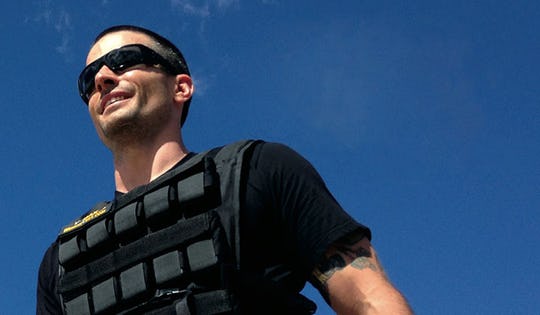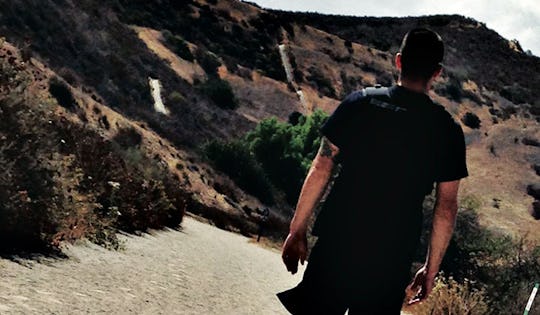Blasted by frozen air, every breath was cracked and painful but necessary to keep my muscles from collapse. I just needed water. Yet, I had none. Fatigue had set in so severely that I couldn’t remember that last two hours (I was I sleeping and walking at the same time). “Pay attention!” I tell myself inside the doldrums of my brain activity, which seems to only be able to think of the next step instead of the training scenario I am supposed to be actively a part of.
It is night again, and I have already trekked over 40 miles in 36 hours without sleep, and a 50-pound pack on my back with weapon. This training operation has become almost asinine because I am one of 8 left, when we started with over 40. The one thing that remains in my mind is that I won’t give up.
The never quit attitude will hold me unless I pass out, get hurt, or get pulled by my superior officers. The straps of my pack feel like they have burrowed two ditches through my traps, and the weight on my back bury my feet inside themselves with every step.
#1: The Ancients Were Accustomed to Weighted Carries
The thought of walking with 50-pounds or more on your back may not be that appealing until you understand some of the spectacular transformations you will receive by undertaking one of the most ancient forms of exercise.
When people needed to move from one place to another, they had to haul their personal be- longings with them, and there wasn’t always enough livestock to carry all of their property with them.
#2: Is Weighted Carries Training for Survival Situations Just Trendy?
Think about it, if you hit a tree with your car in the middle of nowhere without cell phone service, would you be able to carry your hurt passenger to the next town? Or let’s look at some scenarios that have actually happened: Hurricane Katrina, Japan Tsunami, Indonesian Tsunami, San Francisco Earthquake, Great New England Hurricane, Tri-state Tornado, plus many heat waves and cold spells.
Even societal collapse in history is telling us there is a distinct possibility of collapse, and collapses have already happened in countries in Europe, Africa, and Asia. In all of these scenarios thousands and even millions of people needed to relocate without the use of cars, livestock, or air travel.
What does that mean for us? We must get familiar with some weight on our bodies for miles and miles at a time if we are to be prepared for an inevitable situation within our lifetime.
#3: Neuromuscular Benefits of Weighted Carries
One meeting with Dan John or John Brookfield, and you will quickly assess the importance of loaded carries and force accumulation over time. These gentle giants have done more endurance activities under heavy loads than most of us could dream up.
What has it given them in exchange? An intense, almost circus-like ability in the power and endurance arenas. I have seen John Brookfield bend a twenty foot steel bar into a small box, pull a 31,000-pound truck for a mile, and stay in the push-up position for hours at a time.
Dan John says the secret to heavy lifts is covering time or distance with heavy loads. They both give experiential reasons for doing this, and they have proven weighted carries worth time and again in their incredible feats of strength, as well as their athlete’s incredible feats of strength, which is why Perform Better uses their lectures and hands-on teaching repeatedly.
#4: Mental & Physical Endurance from Weighted Carries
Besides the neuromuscular advancement that occurs in the body when you hike weight over longer periods of time, you will also break through several mental and physical barriers as well. Most of the mental and physical benefit are driven by one small debilitating item: pain. If you face two athletes against each other in a game, it is usually the most athletic individual that will win (which is usually measured by explosive power under control or with agility).
However, if the game is long, rest is suddenly shortened, or the athletes have to compete again and again (which is what happens in real life), it is pain-tolerance, mental toughness, and heart that always wins out.
The heavy trek gives perspective in life and in the gym. If you have pulled a chain for a half-mile, a couple of really heavy deadlifts don’t seem so scary. When you carry an 80-pound pack for 40 miles, the thought of carrying your hurting child down five flights of stairs and around the block to an emergency room wouldn’t even faze you.
Besides building foot, ankle, and core strength, it brings a whole new meaning to work capacity, task management, technical efficiency, lactic threshold, mental toughness, and the never-quit attitude needed to succeed in sports and life.
Weighted Carries & The Rest of the Story
As the sun came up over Camp Pendleton, I knew I had a chance to finish this grueling test of mind, body, and spirit. I was able to fuel up with water and briskly make it to the very end of the event. When it was done, I was very relieved, but more than relief, I felt stronger, more focused, tougher, and more courageous than when I started.
The benefits of pushing yourself to the end of your psychological and physical rope is that there is an increased confidence that cannot be achieved with hour-long workouts, no matter how intense they are. I became the best Marine in my particular unit, and was able to lead Marines through combat situations confidently because of many scenarios like this one that I experienced as a young Marine.
I encourage you to pick up some heavy weight and begin to see the bottomless reward that you will receive from Weighted Carries
Weighted Carries Workout #1: Ruck Progression:
The Ultimate goal would be to do an 80lb ruck for 40 miles.
| Week | Mon/Tues | Wed/Thur | Fri/Sat |
| 1 | 40lb pack, 3 miles | 40lb pack, 5 miles | 30lb pack, 6 miles |
| 2 | 50lb pack, 2 miles | 30lb pack, 3 miles | 40lb pack, 7 miles |
| 3 | 40lb pack, 4 miles | 30lb pack, 5 miles | 50lb pack, 8 miles |
| 4 | 60lb pack, 2 miles | 40lb pack, 3 miles | 60lb pack, 9 miles |
| 5 | 50lb pack, 3 miles | 30lb pack, 7 miles | 70lb pack, 10 miles |
| 6 | 60lb pack, 4 miles | 40lb pack, 5 miles | 80lb pack, 11 miles |
| 7 | 50lb pack, 5 miles | 60lb pack, 3 miles | 80lb pack, 13 miles |
Weighted Carries Workout #2: Weighted Carries Simple Progression
The goal would be to do each of these for a minimum of a mile.
| Week | Chain Drag (80-120lb chain strapped around waist or shoulders) |
Farmers Carry (75-150lbs in each hand) |
Heavy Bag Carry (50-120lb bag front carry) |
| 1 | 100 yards (forward,backward, right, left) |
100 yards forward only | 50 yard carry |
| 2 | 200 yards each way | 100 yards forward/backward | 75 yard carry |
| 3 | 300 yards each way | 125 yards forward/backward | 100 yard carry |
| 4 | 400 yards each way | 150 yards forward/backward | 125 yard carry |
| 5 | 500 yards each way | 175 yards forward/backward | 150 yard carry |
| 6 | 600 yards each way | 200 yards forward/backward | 175 yard carry |
| 7 | 700 yards each way | 225 yards forward/backward | 200 yard carry |
| 8 | 800 yards each way | 250 yards forward/backward | 225 yard carry |
Weighted Carries Workout #3: Weighted Carries Complexes
The goal would be to do each of these for a half mile.
| Week | Chain Drag with Farmers Carry |
Ruck and Heavy Bag Carry |
Backwards Ruck and Chain Drag with Hands |
| 1 | Maximum distance, rest, and then come back |
Maximum distance, rest, and then come back |
Maximum distance, rest, and then come back |
| 2 | Maximum distance, rest, and then come back |
Maximum distance, rest, and then come back |
Maximum distance, rest, and then come back |
| 3 | Maximum distance, rest, and then come back |
Maximum distance, rest, and then come back |
Maximum distance, rest, and then come back |


)





